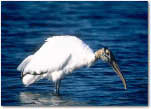The three-year work order associated with this project is designed to continue and enhance monitoring of populations of breeding wading birds in the south Florida ecosystem. Wading birds are a dominant predator in the Greater Everglades region and represent a large part of the vertebrate biomass; breeding population responses are considered to be integrative and reflective of many aspects of the wetland habitat. Success and productivity of breeding is also predicted to improve, especially for two species specifically for which past information is available - Wood Storks and Roseate Spoonbills. This project continues to build on an existing database of reproductive success and productivity information extending back to the 1960's for Wood Storks and to the 1930's for spoonbills and it continues a large and fruitful wading bird dataset which has already served as an early warning of the collapse of ecosystem function, the widespread contamination of the wetland biota with mercury, and the critical functions provided by droughts, to name a few.
Wading Bird Colony Location, Size, Timing and Wood Stork and Roseate Spoonbill Nesting Success

photo courtesy of the South Florida Water Management DistrictInvestigators: Franklin Percival, Peter Frederick and Jerry Lorenz
Summary
The objectives of this project are to provide for annual monitoring of size, location, and species composition of nesting aggregations, to provide annual quantitative information on nest success and nest productivity, to standardize methods and integrate results, to develop and refine systematic survey methods, and to provide an annual report with species-specific estimates of breeding wading birds.
Scope of Work
